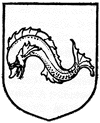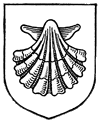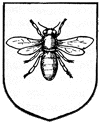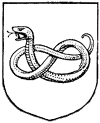Charges: Fish, Insects & Reptiles
Fish, insects, and reptiles, though not as common, still have their place in heraldry. Unlike modern classifications of fish, heraldic charges considered to be "fish" include dolphins, wales, and other sea creatures. Like birds and beasts, the positioning of fish takes on different forms. The symbol of the bee is probably the most widely used insect in heraldic charges, considered to represent industry. Other insects in use include ants, butterflies, and crickets. Reptiles other than serpents are rare in heraldic charges, with the snake being the most prominent. It's position differs depending on the charge. Other reptiles used in heraldry include toads or frogs and lizards.
Fish & Other Sea Charges
In addtion to the charges below, other possible charges in this category which we do not have illustrations for at this time include: crab, eel, herring, lobster, pike or jack (a.k.a. lucy or ged), salmon, shrimp, trout and whale.
-

heraldic dolphin naiant 
heraldic dolphin hauriantA heraldic dolphin will always appear enbowed (i.e., curved). If the dolphin is neither naiant nor hauriant, it is simply described as embowed.

escallop
whelk shell
Insects
In addition to the bee, other possible charges in this category which we do not have illustrations for at this time include: ant, butterfly, cricket, grasshopper and spider.

bee volantA bee might also be found; walking in profile with its wings elevated; perched upon a thistle. The bee appears more often in the crest than as a part of the armorial.
Reptiles
In addition to the serpent, other possible charges in this category which we do not have illustrations for at this time include: toad or frog, lizard, turtle or tortoise.

serpent nowedA serpent may also be found: erect (i.e., on its tail); glissant (i.e., gliding); encircled with its tail in its mouth, an ancient symbol of eternity. The arms of doctors or physicians may include the rod of Æsculapius (i.e., one or two sepernts twined around a staff).
General RBSC Hours
- Mon - Fri
- 9:30am - 4:30pm
- Sat - Sun
- CLOSED
For exceptions and Hesburgh Library information, view All Library Hours

 |
| 